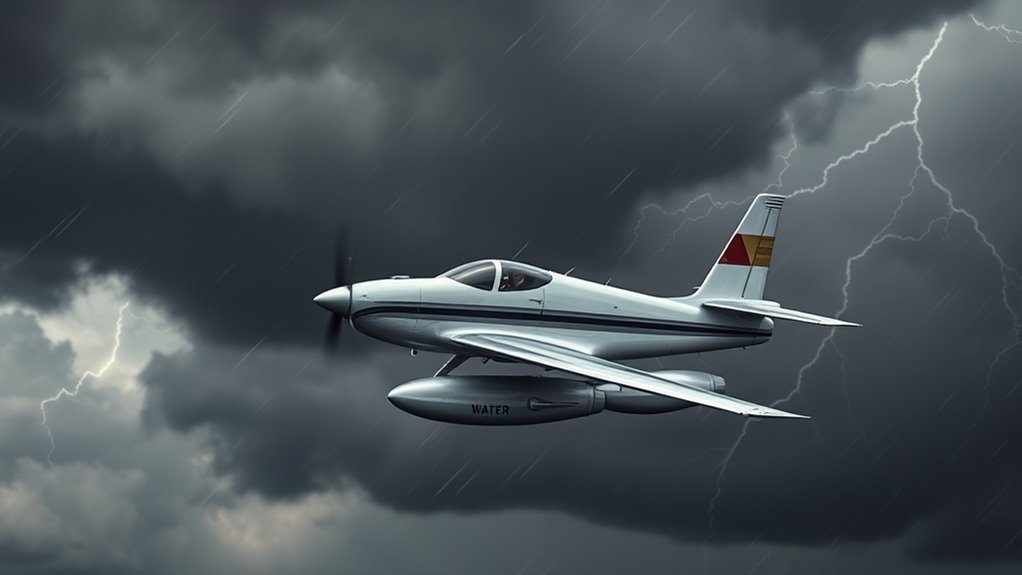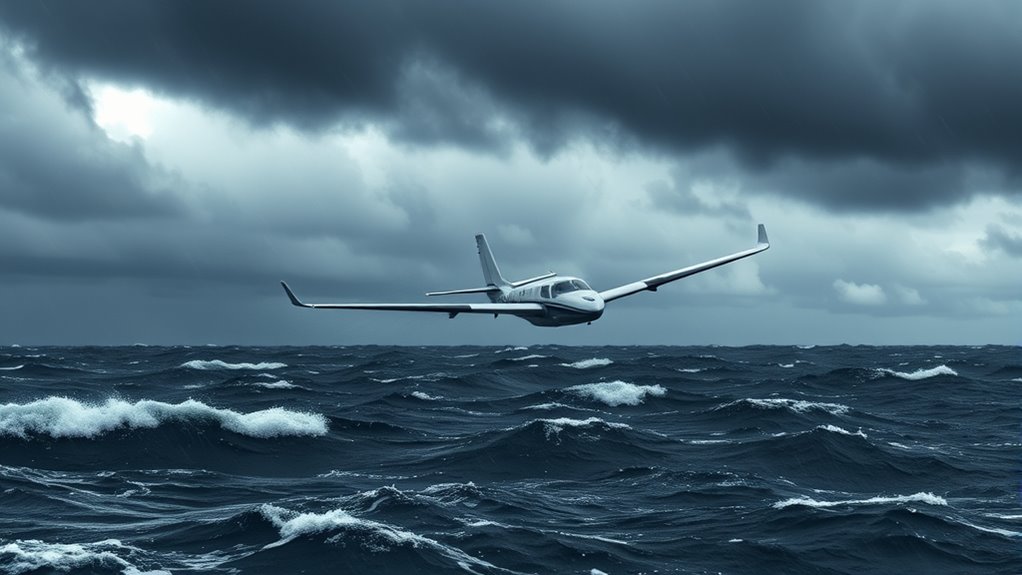Using water ballast in strong conditions can boost your aircraft’s stability and control, helping you handle gusty or turbulent weather more smoothly. It lowers the center of gravity, reducing buffeting and making responses more predictable. However, managing ballast requires careful planning to avoid overload and potential structural issues. If you’re cautious and attentive, you’ll maximize safety and performance — and here’s more to contemplate for effective ballast strategies.
Key Takeaways
- Water ballast improves flight stability and control in turbulent or gusty weather conditions.
- Proper management reduces risks of over-ballasting, which can compromise safety and aircraft performance.
- Excessive ballast increases weight, affecting speed, climb rate, and fuel efficiency.
- Adjusting ballast during flight helps maintain optimal center of gravity amid changing conditions.
- Responsible use enhances safety and performance but requires precise handling and planning.

Flying with water ballast in strong conditions requires careful planning and precise handling. When you add ballast weight to your aircraft, you’re intentionally increasing its overall weight to optimize performance, especially in turbulent or challenging weather. Water ballast can considerably improve your aircraft’s flight stability by lowering its center of gravity and enhancing control during gusty conditions. However, you must be aware that managing this additional weight demands meticulous attention, as improper handling can compromise safety and efficiency.
Water ballast enhances stability but requires careful handling to ensure safety and optimal performance.
The primary benefit of using water ballast is the enhanced flight stability it offers. In strong conditions, the added ballast helps keep your aircraft more grounded, reducing the effects of wind buffeting and sudden turbulence. It makes your aircraft more predictable in its responses, allowing you to maintain better control. This stability translates into a smoother flight, especially when flying through areas with unpredictable wind patterns. But, keep in mind that the ballast weight also influences your aircraft’s handling characteristics. If you don’t adjust your flying techniques accordingly, you might find yourself fighting against the aircraft rather than with it.
Adding ballast weight requires you to be conscious of your aircraft’s weight limits and distribution. Excessive ballast can push you beyond safe operating parameters, risking structural stress or reduced maneuverability. Hence, it’s essential to calculate the precise amount of water needed to achieve the desired balance. You don’t want to over-ballast, nor do you want to under-balance, as both situations can impair your aircraft’s performance. Properly distributed ballast helps maintain the aircraft’s center of gravity, ensuring your controls remain responsive and predictable. You’ll need to monitor your instruments closely, especially during takeoff and landing, because the increased weight affects your aircraft’s speed, climb rate, and braking distance.
Additionally, understanding how resources and tools can aid in planning and managing ballast loading can enhance safety and efficiency during your flight. In strong conditions, handling water ballast requires a keen sense of timing and technique. You should be prepared to adjust ballast quickly if weather conditions change or if you notice your aircraft becoming less responsive. Managing ballast also means being aware of the potential for increased fuel consumption and wear on your aircraft’s structure. Always plan your ballast loading strategy before starting your flight, and remain vigilant throughout to ensure that your aircraft remains within safe operational limits. When done correctly, water ballast can be a powerful tool to improve flight stability and safety in demanding weather, but it’s essential to use it responsibly and with a thorough understanding of your aircraft’s capabilities.
Frequently Asked Questions
How Does Water Ballast Affect Aircraft Fuel Efficiency?
Water ballast increases your aircraft’s weight, which can lead to higher fuel consumption because the engine works harder to maintain altitude and speed. It also affects weight distribution, potentially impacting fuel efficiency and handling. While ballast helps with stability in strong conditions, it can reduce overall fuel efficiency, so you might need to plan for increased fuel use or adjust your flight strategy accordingly.
What Are the Best Safety Precautions for Water Ballast Deployment?
You should double-check ballast stability before deployment, guarantee secure connections, and monitor water levels continuously. Always verify proper water management to prevent shifting or imbalance. Use dedicated safety equipment, follow manufacturer guidelines, and conduct pre-flight checks to identify potential issues. Communicate clearly with your crew about ballast procedures, and stay vigilant throughout the process. These precautions help maintain aircraft safety, optimize ballast stability, and ensure effective water management during strong conditions.
Can Water Ballast Be Used During All Weather Conditions?
You can’t use water ballast during all weather conditions safely. Weather adaptability is key, as strong winds, turbulence, or storms make ballast management risky. In such conditions, water ballast can shift unexpectedly or cause instability. Always assess current weather, and if conditions are rough, consider removing ballast or postponing the flight. Proper ballast management guarantees your safety and aircraft stability, so never ignore weather factors when deciding to use water ballast.
How Does Water Ballast Impact Aircraft Handling During Turbulence?
Imagine the thrill of turbulence, now stabilized by water ballast. You’ll notice improved aircraft stability, as the added weight dampens sudden movements. During turbulence mitigation, water ballast helps keep your aircraft steady, reducing sudden jolts and making the ride smoother. While it can make handling feel more responsive in strong conditions, you might also experience a slight increase in overall weight, which requires careful management for ideal control.
Are There Legal Restrictions on Carrying Water Ballast in Different Countries?
You should check international regulations and water ballast restrictions before carrying water ballast in different countries. Many countries have specific rules to guarantee safety and environmental protection, which may limit or prohibit water ballast use. It’s your responsibility to research each country’s regulations, as non-compliance can lead to fines or grounding. Always verify the latest rules with relevant authorities to avoid legal issues when transporting water ballast internationally.
Conclusion
Flying with water ballast in strong conditions can give you better control and improve your aircraft’s balance. However, it also adds weight and complexity, which might compromise safety if not managed carefully. The key is understanding that no single approach is perfect; instead, adapt your tactics based on your experience and the situation. Trust in your judgment and remember, sometimes less weight means more control. Properly evaluating the risks ensures a safer, more confident flight.
With a heart that soars as high as the skies, Aria, affectionately known as “Skylark,” is the driving force behind Soaring Skyways. Her journey into the gliding world began as a young dreamer gazing up at the soaring birds, yearning to experience the weightlessness and freedom they embodied. With years of experience both in the cockpit and behind the scenes, Aria’s commitment to the gliding community is unwavering.









